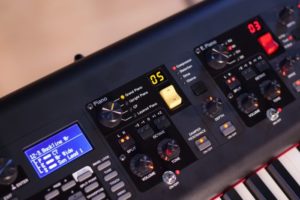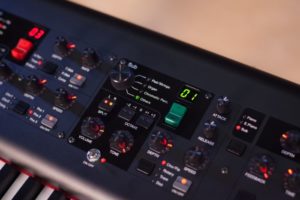As I mentioned in my last post, Yamaha have announced two new stage pianos: CP73 and CP88. Features in common are:
- Three premium grand pianos: CFX, S700 and Bösendorfer Imperial 290
- Two upright piano Voices: vintage U1 and flagship SU7
- Five electric pianos for covering all music genres back to the 1970s
- Yamaha CP OS updates enhance features and add new instrument Voices
- CP OS v1.1 adds 67 Rd (Bright and Dark), Wide Wr & Yamaha C7 grand piano Voices
- Dedicated effects and effect controls for each Section (Piano, E Piano and Sub)
- Master delay, reverb and EQ effects with dedicated realtime controls
- Soundmondo social sound sharing gives access to thousands of free sounds
- Seamless Sound Switching: change sounds while holding notes without sound cutoff
- One-to-one UI for direct sound control during stage or studio performance
- 2 Ch. USB Audio/MIDI Interface for audio recording and playback & MIDI control
- Balanced XLR & unbalanced 1⁄4” stereo outputs covers a wide-range of connectivity
- Four-zone Master Keyboard mode lets you control external hardware and software
- Dual 1/4″ AUX line inputs connects second keyboards, mobile devices and more
The CP88 has an NW-GH3 keyboard with synthetic ebony and ivory key tops and the CP73 has a balanced hammer 73-note action. The CP88 is 41 pounds while the CP73 is a lighter 28.9 pounds. How much is this going to set ya back? CP88: $2,499.99 and CP73: $1,999.99.
Here’s a link to the official Yamaha demo (no yakking).
Kraft Music has demo videos with no talking and a full demo with Blake Angelos. The Kraft demo shows off the CP73, which looks quite portable! The Sub adds a the usual pads, synths and things, but has its own tricks. In the non-talking demo, Blake shows off a “live looping” type performance at roughly 6:00. And, yes, the CP does B-3. Blake shows off “All Bars Out” starting at 8:30 with rotary speed changes.
As I mentioned earlier, these instruments are built for pros. The acoustic pianos have wide dynamic range — no cheap out sampling. The chassis is sturdy aluminum. Both models provide balanced XLR outputs and internal power supply (no wall wart). The front panel interface is divided into sections: Live Set, acoustic piano, electric piano, sub and master. Each section is enabled by retro toggle switches. If you scan the front panel, there are lots and lots of (dedicated) digital effects. The sub section adds pad/strings, organ, chromatic percussion and other (bass, guitar, etc.). [Wish I knew what else is hiding under “other.”]
The auxiliary inputs do not route through the internal effects. Shame, lost opportunity, but could save hauling a separate mixer to small piano gigs. External audio can be routed through USB into the CP.
A big question is “Are the CP73 and CP88 Nord Stage killers?” Hmmm, no real-time drawbar control and no “mini synth” like the Stage. On the other hand, the CPs have Advanced Mode for creating novel instrument and effect routing (e.g., looping). Yamaha makes excellent, pro digital pianos (stage, studio, or home). So, if piano were my primary instrument, I would definitely have a fly-off between the CP and Stage before putting one on the credit card.
Copyright © 2019 Paul J. Drongowski



